Characteristics and Mechanisms of Debris Bed Formation Behavior in Severe Accidents of Sodium-Cooled Fast Reactors: Experimental and Modeling Studies
Abstract
1. Introduction
2. Investigations Focusing on Overall Accumulated-Bed Characteristics
2.1. Investigations with Single-Sized and Single-Shaped Solid Particles
2.1.1. Experimental Materials and Methods
2.1.2. Experimental Results and Discussion
2.1.3. Modeling Studies
2.2. Investigations with Mixed Solid Particles
2.2.1. Experimental Materials and Methods
2.2.2. Experimental Results and Discussion
2.2.3. Modeling Studies
3. Investigations Focusing on Flow Regime Characteristics
3.1. Investigations with Single-Sized Spherical Particles
3.1.1. Experimental Materials and Methods
3.1.2. Experimental Results and Discussion
3.1.3. Modeling Studies
3.2. Investigations with Single-Sized Non-Spherical Particles
3.2.1. Experimental Materials and Methods
3.2.2. Experimental Results and Discussion
3.2.3. Modeling Studies
3.3. Investigations with Mixed-Sized Spherical Particles
3.3.1. Experimental Materials and Methods
3.3.2. Experimental Results and Discussion
3.3.3. Modeling Studies
3.4. Investigations on the Effect of Coolant Boiling Caused by Accumulated Debris
3.4.1. Experimental Studies Using the Gas-Injection Method
3.4.2. Experimental Studies Using the Bottom-Heated Method
- (1)
- For the non-bubbling cases, pool convection is triggered by the falling particle jet and, thus, is limited within the center area. Therefore, the particles are driven away inside a relatively small region (such as around the two apexes of the bed). While for bubbling cases, due to the rather uniform distributions of bubbles in the pool, the influence area of pool convection is deemed to be wider.
- (2)
- Although increasing the water depth was found to generally enhance pool convection under non-bubbling conditions, for boiling conditions at a constant heating power, due to the larger water mass and the potentially enhanced heat dissipation resulting from larger heat-transfer areas within the environment, a higher water depth might also lead to reduced bubbling rate, thereby reducing the overall intensity of pool convection to some extent [71].
3.5. Investigations on the Effect of Coolant Boiling Caused by Falling Debris
3.5.1. Experimental Materials and Methods
3.5.2. Experimental Results and Discussion
3.5.3. Modeling Studies
4. Conclusions
5. Discussion of Future Prospects
- (1)
- Further analyses and validations of DBF characteristics in cases of multicomponent (i.e., more than three components) mixed-sized particles. As noted in Section 2 and Section 3, previous investigations under mixed-sized spherical particle conditions were carried out by only using bicomponent or a few tricomponent mixed-sized particle mixtures. To attain more reliable insights into DBF behavior under more realistic particulate situations, more experimental studies, as well as corresponding modeling verifications, with three (or even more) component mixed-size solid particles can be conducted.
- (2)
- Further experimental investigations on the characteristics of particle separation and stratification under mixed-size particle conditions. As mentioned in Section 3, from experiments focusing on flow regime characteristics, it was implied that the stratifications and separations of different particle components in the mixtures, which may affect the coolability of the debris beds, can possibly appear under some specific accident situations (e.g., significant sodium boiling) as a result of the differences in component inertia. Therefore, to study the characteristics of particle separations and stratifications, experiments using mixed-size particles can be carried out under the gas-injection method, which can effectively simulate the violent sodium boiling conditions.
- (3)
- Further experimental and modeling studies under mixed-density conditions. For the experimental studies, although fundamental mixed-density influences were preliminarily investigated through several experiments focusing on accumulated-bed characteristics, it is necessary to point out that due to the rather limited experimental parametric conditions and non-visual experimental processes, some potential valuable experimental evidence may have been missed. Therefore, mixed-density experiments should be continuously performed under more realistic parametric situations (e.g., smaller particle size and particle mixtures composed of components with densities comparable to the densities of debris in actual reactor accidents (such as MOX fuel and SS)) and in a visual quasi-2D water tank to study in detail the flow regime mechanism under mixed-density particle conditions. Again, since the particle inertia for mixed-density particle components is different, it is reasonable to imagine that particle separation and stratification phenomena may also be found and investigated in bubbling cases with mixed-density particles. Further, for the modeling studies, referring to the modeling developments regarding the molten-pool sloshing and debris bed self-leveling behaviors [81,82], some effective (or equivalent) density to estimate the overall density of the particle mixture can be tested by employing the base model. Further, the establishment of an extension scheme that can appropriately take the mixed-density effect into account can also be attempted.
- (4)
- Further modeling studies for bubbling conditions. To continuously extend the model’s predictability, an extension scheme can be developed for bubbling conditions. Preliminarily, considering the gas-injection cases, the modeling frameworks can be developed as follows:where KGI is a new extension scheme. Theoretically, KGI is required to ensure two points: (1) KGI should monotonously increase as Qg becomes larger to represent the effects of the gas flow rate on promoting pool convection and diminishing particle inertial impact; and (2) KGI should become 1.0 if no gas is injected (i.e., Qg = 0 L/min) to guarantee the applicability of the base model for non-bubbling cases.Here, it is also noted that the gas flow rate considered in our previous investigations may not cover the possible range of vapor flow rates from the drastic boiling induced by the accumulated debris beds in an actual CDA of an SFR [59,83]. Therefore, further experiments with wider ranges of gas flow rates may also be necessary to ensure the predictability of the extended model under accidental conditions.
- (5)
- Further investigations under large-scale 3D conditions. Although essentially consistent parametric effects on characteristics of DBF were confirmed in both 2D flow regime and 3D accumulated-bed experiments, it should be highlighted again that an insufficiently large range of parameters for the 3D accumulated-bed experiments in the comparison to that of actual accident conditions may cause the loss of valuable evidence (such as additional variation in particle bed shape). Through elaborately performing the large-scale 3D experiments, insights obtained from 2D flow-regime experiments are expectable to be further verified under the large-scale 3D conditions. It can be expected that a more applicable and dependable empirical model associating the flow regime and accumulated-bed characteristics can be developed for application in reactor safety assessments. In fact, referring to the previous modeling studies on debris bed self-leveling behavior [14,84], it can be expected that the flow regime boundary lines (or empirical constants) determined for the predictive model under 2D conditions can possibly vary to some degree for large-scale 3D predictions. Such a predictive model is supposed to be useful in the improved designs of in-vessel core catchers along with the developments and validations of SFR safety analysis codes.
Author Contributions
Funding
Institutional Review Board Statement
Informed Consent Statement
Data Availability Statement
Conflicts of Interest
Nomenclature
| A | area | ρ | density |
| Ar | Archimedes number | σ | surface tension |
| C | specific heat | ϕ | particle sphericity |
| D | diameter of experimental device | ψ | quantities for characterizing |
| d | diameter | bubbling impact on restricting the | |
| mean diameter | particle-flow induced pool convection | ||
| Fr | Froude number | Ω | degree of convergence in particle |
| g | gravitational acceleration | size distribution | |
| H | height | ||
| hlg | latent heat of liquid | Subscripts | |
| L | length of experimental device | a | stands for an area mean term |
| m | mass | B | boiling |
| P | heating power | b | particle bed |
| ΔP | pressure-drop | c | critical value |
| Q | flow rate | dim | dimple |
| Re | Reynolds number | ev | stands for a volume-equivalent term |
| T | temperature | f | fluid |
| t | the time span between the first and last particles | g | gas |
| that flows out of the particle-releasing nozzle | in | inner container | |
| U | superficial velocity | ip | represents an initial value of particle |
| V | volume | j | j-th size particles |
| v | velocity | L | left |
| VT | particle terminal velocity | l | liquid |
| VTS | terminal velocity of a spherical particle with the | m | particle mound |
| volume-equivalent diameter of non-spherical particle | n | nozzle | |
| W | width of experimental device | p | particle |
| pr | particle releasing | ||
| Greek symbols | R | right | |
| ε | bed voidage | r | repose |
| θ | angle | tank | water tank |
| λ | thermal conductivity | v | stands for a mean volume term |
| μ | viscosity | w | water |
| Abbreviation | |||
| CDA | Core Disruptive Accident | PAHR | Post-Accident Heat Removal |
| DBF | Debris Bed Formation | PAMR | Post-Accident Material Relocation |
| IGCAR | Indira Gandhi Centre for Atomic Research | SFR | Sodium-cooled Fast Reactor |
| IVR | In-Vessel Retention | SS | Stainless Steel |
| JAEA | Japan Atomic Energy Agency | SYSU | Sun Yat-Sen University |
References
- OECD Nuclear Energy Agency. Technology Roadmap Update for Generation IV Nuclear Energy Systems; Generation IV International Forum (GIF); OECD Nuclear Energy Agency: Paris, France, 2014. [Google Scholar]
- Raj, B.; Chellapandi, P.; Rao, P.V. Sodium Fast Reactors with Closed Fuel Cycle; CRC Press: Boca Raton, FL, USA, 2015. [Google Scholar]
- Xu, R.; Cheng, S. Review of the molten-pool sloshing motion in case of Core Disruptive Accident: Experimental and modeling studies. Prog. Nucl. Energy 2021, 133, 103647. [Google Scholar] [CrossRef]
- Marchaterre, J.F. Overview of core disruptive accidents. Nucl. Eng. Des. 1977, 42, 11–17. [Google Scholar] [CrossRef]
- Maschek, W.; Li, R.; Matzerath Boccaccini, C.; Gabrielli, F.; Morita, K. Investigation on upper bounds of recriticality energetics of hypothetical core disruptive accidents in sodium cooled fast reactors. Nucl. Eng. Des. 2018, 326, 392–402. [Google Scholar] [CrossRef]
- Yamano, H. Thermal-Hydraulic Phenomena Contributing to Reactivity Mitigation in Core Disruptive Accidents of Fast Reactors. Ph.D. Thesis, Kyushu University, Fukuoka, Japan, 2009. [Google Scholar]
- Ohshima, H.; Kubo, S. Handbook of Generation IV Nuclear Reactors; Woodhead Publishing: Manchester, UK, 2016. [Google Scholar]
- Yamano, H.; Sato, I.; Tobita, Y. Development of technical basis in the initiating and transition phases of unprotected events for Level-2 PSA methodology in sodium-cooled fast reactors. Nucl. Eng. Des. 2012, 249, 212–227. [Google Scholar] [CrossRef]
- Sato, I.; Yamano, H.; Tobita, Y. Development of Severe Accident Evaluation Technology (Level 2 PSA) for Sodium-Cooled Fast Reactors—Identification of Dominant Factors in Initiating Phase of Unprotected Events. In Proceedings of the 2009 International Congress on Advances in Nuclear Power Plants (ICAPP’09), Tokyo, Japan, 10–14 May 2009. [Google Scholar]
- Yamano, H.; Tobita, Y.; Fujita, S. A three-dimensional neutronics-thermohydraulics simulation of core disruptive accident in sodium-cooled fast reactor. Nucl. Eng. Des. 2009, 239, 1673–1681. [Google Scholar] [CrossRef]
- Morita, K.; Matsumoto, T.; Emura, Y.; Abe, T.; Tatewaki, I.; Endo, H. Investigation on Sloshing Response of Liquid in a 2D Pool against Hydraulic Disturbance. In Proceedings of the Ninth Korea-Japan Symposium on Nuclear Thermal Hydraulics and Safety (NTHAS-9), Buyeo, Republic of Korea, 16–19 November 2014. [Google Scholar]
- Xu, R.; Cheng, S. Experimental and numerical investigations into molten-pool sloshing motion for severe accident analysis of sodium-cooled fast reactors: A review. Front. Energy Res. 2022, 10, 893048. [Google Scholar] [CrossRef]
- Tatewaki, I.; Morita, K.; Endo, H. A Study on Characteristics of Molten Pool Sloshing in Core Disruptive Accidents of Fast Reactors. In Proceedings of the 23rd International Conference on Nuclear Engineering: Nuclear Power-Reliable Global Energy (ICONE-23), Chiba, Japan, 17–21 May 2015. [Google Scholar]
- Xu, R.; Cheng, S. Debris Bed Self-Leveling Mechanism and Characteristics for Core Disruptive Accident of Sodium-Cooled Fast Reactor: Review of Experimental and Modeling Investigations. Sci. Technol. Nucl. Install. 2022, 2022, 2755471. [Google Scholar] [CrossRef]
- Xu, Y.; Xu, R.; Cheng, H.; Liu, X.; Cheng, S. Numerical simulation of jet breakup phenomenon during severe accident of sodium-cooled fast reactor using MPS method. Ann. Nucl. Energy 2022, 172, 109087. [Google Scholar] [CrossRef]
- Cheng, S.; Yamano, H.; Suzuki, T.; Tobita, Y.; Nakamura, Y.; Zhang, B.; Matsumoto, T.; Morita, K. Characteristics of self-leveling behavior of debris beds in a series of experiments. Nucl. Eng. Technol. 2013, 45, 323–334. [Google Scholar] [CrossRef]
- Fauske, H.K.; Koyama, K. Assessment of fuel coolant interactions (FCIs) in the FBR core disruptive accident (CDA). J. Nucl. Sci. Technol. 2002, 39, 608–614. [Google Scholar] [CrossRef]
- Koyama, K.; Yamada, Y.; Hayakawa, S.; Watanabe, M.; Watanabe, O. Development of severe accident evaluation technology (level 2 PSA) for sodium-cooled fast reactors; dentification of Dominant Factors in Core Material Relocation and Heat Removal Phases. In Proceedings of the International Congress on Advances in Nuclear Power Plants (ICAPP’09), Tokyo, Japan, 10–14 May 2009. [Google Scholar]
- Suzuki, T.; Tobita, Y.; Nakai, R. Evaluation of recriticality behavior in the material-relocation phase for Japan sodium-cooled fast reactor. J. Nucl. Sci. Technol. 2015, 52, 1448–1459. [Google Scholar] [CrossRef]
- Bala Sundaram, G.; Velusamy, K. Effect of debris material composition on post accidental heat removal in a sodium cooled fast reactor. Nucl. Eng. Des. 2021, 375, 111065. [Google Scholar] [CrossRef]
- Lipinski, R.J. A Coolability Model for Postaccident Nuclear Reactor Debris. Nucl. Technol. 1984, 65, 53–66. [Google Scholar] [CrossRef]
- Lipinski, R.J.; Gronager, J.E.; Schwarz, M. Particle Bed Heat Removal with Subcooled Sodium: D-4 Results and Analysis. Nucl. Technol. 1982, 58, 369–378. [Google Scholar] [CrossRef]
- Shamsuzzaman, M.; Horie, T.; Fuke, F.; Kai, T.; Zhang, B.; Matsumoto, T.; Morita, K.; Tagami, H.; Suzuki, T.; Tobita, Y. Experimental Evaluation of Debris Bed Characteristics in Particulate Debris Sedimentation Behaviour. In Proceedings of the 21st International Conference on Nuclear Engineering, Chengdu, China, 29 July–2 August 2013. [Google Scholar]
- Lin, S.; Cheng, S.; Jiang, G.; Pan, Z.; Lin, H.; Wang, S.; Wang, L.; Zhang, X.; Wang, B. A two-dimensional experimental investigation on debris bed formation behavior. Prog. Nucl. Energy 2017, 96, 118–132. [Google Scholar] [CrossRef]
- Matsuba, K.; Isozaki, M.; Kamiyama, K.; Tobita, Y. Distance for fragmentation of a simulated molten-core material discharged into a sodium pool. J. Nucl. Sci. Technol. 2016, 53, 707–712. [Google Scholar] [CrossRef]
- Tentner, A.; Parma, E.; Wei, T.; Wigeland, R. Severe Accident Approach-Final Report; Evaluation of Design Measures for Severe Accident Prevention and Consequence Mitigation; Argonne National Laboratory: Argonne, IL, USA, 2010. [Google Scholar]
- Suzuki, T.; Kamiyama, K.; Yamano, H.; Kubo, S.; Tobita, Y.; Nakai, R.; Koyama, K. A scenario of core disruptive accident for Japan sodium-cooled fast reactor to achieve in-vessel retention. J. Nucl. Sci. Technol. 2014, 51, 493–513. [Google Scholar] [CrossRef]
- Sheikh, M.; Son, E.; Kamiyama, M.; Morioka, T.; Matsumoto, T.; Morita, K.; Matsuba, K.; Kamiyama, K.; Suzuki, T. Sedimentation behavior of mixed solid particles. J. Nucl. Sci. Technol. 2018, 55, 623–633. [Google Scholar] [CrossRef]
- Shamsuzzaman, M.; Horie, T.; Fuke, F.; Kamiyama, M.; Morioka, T.; Matsumoto, T.; Morita, K.; Tagami, H.; Suzuki, T.; Tobita, Y. Experimental study on debris bed characteristics for the sedimentation behavior of solid particles used as simulant debris. Ann. Nucl. Energy 2018, 111, 474–486. [Google Scholar] [CrossRef]
- Park, S.; Park, H.S.; Jeun, G.; Cho, B.J. Three-Dimensional Modeling of Debris Mixing and Sedimentation in Severe Accidents Using the Moving Particle Semi-Implicit Method Coupled with Rigid Body Dynamics. Nucl. Technol. 2013, 181, 227–239. [Google Scholar] [CrossRef]
- Vasilyev, B.A.; Shepelev, S.F.; Ashirmetov, M.R.; Poplavsky, V.M. BN-1200 Reactor Power Unit Design Development. In Proceedings of the International Conference on Fast Reactors and Related Fuel Cycles: Safe Technologies and Sustainable Scenarios (FR13), Paris, France, 4–7 March 2013. [Google Scholar]
- Harvey, J.; Narayanan, K.S.; Das, S.K.; Rao, E.V.H.M.; Lydia, G.; Malarvizhi, B.; Murthy, S.S.; Kumaresan, M.; Kasinathan, N.; Rajan, M. Assessment of Debris Bed Formation Characteristics Following Core Melt Down Scenario with Simulant System. In Proceedings of the 16th International Conference on Nuclear Engineering, Orlando, FL, USA, 11–15 May 2008. [Google Scholar]
- Ma, W.; Dinh, T.-N.; Buck, M.; Buerger, M. Analysis of the Effect of Bed Inhomogeneity on Debris Coolability. In Proceedings of the 15th International Conference on Nuclear Engineering (ICONE15), Nagoya, Japan, 22–26 April 2007. [Google Scholar]
- Yakush, S.; Kudinov, P.; Dinh, T.N. Modeling of Two-Phase Natural Convection Flows in a Water Pool with a Decay-Heated Debris Bed. In Proceedings of the 2008 International Congress on Advances in Nuclear Power Plants (ICAPP’08), Anaheim, CA, USA, 8–12 June 2008. [Google Scholar]
- Xiong, Z.; Cheng, S.; Xu, R.; Tan, Y.; Zhang, H.; Xu, Y. Experimental study on eutectic reaction between fuel debris and reactor structure using simulant materials. Ann. Nucl. Energy 2020, 139, 107284. [Google Scholar] [CrossRef]
- Hotta, A.; Akiba, M.; Morita, A.; Konovalenko, A.; Villanueva, W.; Bechta, S.; Komlev, A.; Thakre, S.; Hoseyni, S.M.; Sköld, P.; et al. Experimental and Analytical Investigation of Formation and Cooling Phenomena in High Temperature Debris Bed. J. Nucl. Sci. Technol. 2020, 57, 353–369. [Google Scholar] [CrossRef]
- Alvarez, D.; Amblard, M. Fuel Levelling. In Proceedings of the 5th Information Exchange Meeting on Post Accident Debris Cooling, Karlsruhe, Germany, 28–30 July 1982. [Google Scholar]
- Bürger, M.; Buck, M.; Schmidt, W.; Widmann, W. Validation and application of the WABE code: Investigations of constitutive laws and 2D effects on debris coolability. Nucl. Eng. Des. 2006, 236, 2164–2188. [Google Scholar] [CrossRef]
- Yakush, S.; Kudinov, P. Simulation of Ex-Vessel Debris Bed Formation and Coolability in a LWR Severe Accident. In Proceedings of the ISAMM-2009, Böttstein, Switzerland, 25–28 October 2009. [Google Scholar]
- Ma, W.; Dinh, T.-N. The effects of debris bed’s prototypical characteristics on corium coolability in a LWR severe accident. Nucl. Eng. Des. 2010, 240, 598–608. [Google Scholar] [CrossRef]
- Karbojian, A.; Ma, W.M.; Kudinov, P.; Dinh, T. A scoping study of debris bed formation in the DEFOR test facility. Nucl. Eng. Des. 2009, 239, 1653–1659. [Google Scholar] [CrossRef]
- Zhang, B.; Harada, T.; Hirahara, D.; Matsumoto, T.; Morita, K.; Fukuda, K.; Yamano, H.; Suzuki, T.; Tobita, Y. Experimental investigation on self-leveling behavior in debris beds. Nucl. Eng. Des. 2011, 241, 366–377. [Google Scholar] [CrossRef]
- Cheng, S.; Tagami, H.; Yamano, H.; Suzuki, T.; Tobita, Y.; Zhang, B.; Matsumoto, T.; Morita, K. Evaluation of debris bed self-leveling behavior: A simple empirical approach and its validations. Ann. Nucl. Energy 2014, 63, 188–198. [Google Scholar] [CrossRef]
- Cheng, S.; Tagami, H.; Yamano, H.; Suzuki, T.; Tobita, Y.; Taketa, S.; Nishi, S.; Nishikido, T.; Zhang, B.; Matsumoto, T.; et al. An investigation on debris bed self-leveling behavior with non-spherical particles. J. Nucl. Sci. Technol. 2014, 51, 1096–1106. [Google Scholar] [CrossRef]
- Takasuo, E. An experimental study of the coolability of debris beds with geometry variations. Ann. Nucl. Energy 2016, 92, 251–261. [Google Scholar] [CrossRef]
- Basso, S.; Konovalenko, A.; Yakush, S.E.; Kudinov, P. The effect of self-leveling on debris bed coolability under severe accident condi-tions. Nucl. Eng. Des. 2016, 305, 246–259. [Google Scholar] [CrossRef]
- Cheng, S.; Hirahara, D.; Tanaka, Y.; Gondai, Y.; Zhang, B.; Matsumoto, T.; Morita, K.; Fukuda, K.; Yamano, H.; Suzuki, T.; et al. Experimental investigation of bubbling in particle beds with high solid holdup. Exp. Therm. Fluid Sci. 2011, 35, 405–415. [Google Scholar] [CrossRef]
- Guo, L.; Morita, K.; Tobita, Y. Numerical simulations on self-leveling behaviors with cylindrical debris bed. Nucl. Eng. Des. 2017, 315, 61–68. [Google Scholar] [CrossRef]
- Tagami, H.; Cheng, S.; Tobita, Y.; Morita, K. Model for particle behavior in debris bed. Nucl. Eng. Des. 2018, 328, 95–106. [Google Scholar] [CrossRef]
- Li, C.-Y.; Wang, K.; Pellegrini, M.; Erkan, N.; Okamoto, K. Numerical Simulation and Validation of Debris Bed Self-Leveling Behavior with Mixed-Density Particles Using CFD-DEM Coupling Algorithm. Nucl. Technol. 2022, 208, 843–859. [Google Scholar] [CrossRef]
- Pohlner, G.; Vujic, Z.; Bürger, M.; Lohnert, G. Simulation of melt jet breakup and debris bed formation in water pools with IKE-JET/IKEMIX. Nucl. Eng. Des. 2006, 236, 2026–2048. [Google Scholar] [CrossRef]
- Sun, R.; Wu, L.; Ding, W.; Chen, R.; Tian, W.; Qiu, S.; Su, G. From melt jet break-up to debris bed formation: A review of melt evolution model during fuel-coolant interaction. Ann. Nucl. Energy 2022, 165, 108642. [Google Scholar] [CrossRef]
- Xiang, Y.; Thakre, S.; Ma, W.; Bechta, S. A scoping study on debris bed formation from metallic melt coolant interactions. Nucl. Eng. Des. 2021, 385, 111533. [Google Scholar] [CrossRef]
- Xiang, Y.; Deng, Y.; Fang, D.; Zhao, N.; Ma, W. Experimental investigation on ex-vessel debris bed formation using low melting-point melt of binary metals. Prog. Nucl. Energy 2023, 157. [Google Scholar] [CrossRef]
- Iwasawa, Y.; Sugiyama, T.; Abe, Y. Experiments of melt jet-breakup for agglomerated debris formation using a metallic melt. Nucl. Eng. Des. 2022, 386, 111575. [Google Scholar] [CrossRef]
- Modak, M.; Nirgude, V.V.; Park, H.S.; Choi, Y.J.; Seo, M.R. DAVINCI-SP tests for debris bed formation and spreading in a pool with center conical structure under two-phase condition. Nucl. Eng. Des. 2023, 405. [Google Scholar] [CrossRef]
- Kondo, S.; Konishi, K.; Isozaki, M.; Imahori, S.; Furutani, A.; Brear, D. Experimental study on simulated molten jet-coolant interactions. Nucl. Eng. Des. 1995, 155, 73–84. [Google Scholar] [CrossRef]
- Magallon, D.; Hohmann, H.; Schins, H. Pouring of 100-kg-Scale Molten UO2 into Sodium. Nucl. Technol. 1992, 98, 79–90. [Google Scholar] [CrossRef]
- Tobita, Y.; Kamiyama, K.; Tagami, H.; Matsuba, K.-I.; Suzuki, T.; Isozaki, M.; Yamano, H.; Morita, K.; Guo, L.; Zhang, B. Development of the evaluation methodology for the material relocation behavior in the core disruptive accident of sodium-cooled fast reactors. J. Nucl. Sci. Technol. 2016, 53, 698–706. [Google Scholar] [CrossRef]
- Mathai, A.M.; Sharma, A.K.; Anandan, J.; Malarvizhi, B.; Das, S.K.; Nashine, B.; Chellapandi, P. Investigation of fragmentation phenomena and debris bed formation during core meltdown accident in SFR using simulated experiments. Nucl. Eng. Des. 2015, 292, 87–97. [Google Scholar] [CrossRef]
- Yakush, S.; Kudinov, P.; Dinh, T.N. Multiscale Simulations of Self-Organization Phenomena in the Formation and Coolability of Corium Debris Bed. In Proceedings of the 13th International Topical Meeting on Nuclear Reactor Thermal Hydraulics (NURETH-13), Kanazawa, Japan, 27 September–2 October 2009. [Google Scholar]
- Shamsuzzaman, M.; Horie, T.; Fuke, F.; Kai, T.; Zhang, B.; Matsumoto, T.; Morita, K.; Tagami, H.; Suzuki, T.; Tobita, Y. Experimental Investigation of Debris Sedimentation Behaviour on Bed Formation Characteristics. In Proceedings of the Eighth Japan-Korea Symposium on Nuclear Thermal Hydraulics and Safety (NTHAS8), Beppu, Japan, 9–12 December 2012. [Google Scholar]
- Shamsuzzaman, M.; Matsumoto, T.; Kamiyama, M.; Morioka, T.; Morita, K.; Tagami, H.; Suzuki, T.; Tobita, Y. Experimental study on sedimentation behavior of core debris. In Proceedings of the Ninth Korea-Japan Symposium on Nuclear Thermal Hydraulics and Safety (NTHAS9), Buyeo, Republic of Korea, 16–19 November 2014. [Google Scholar]
- Sheikh, M.; Son, E.; Kamiyama, M.; Morioka, K.; Matsumoto, T.; Morita, K.; Matsuba, K.; Kamiyama, K.; Suzuki, T. Experimental Investigation on Characteristics of Mixed Particle Debris in Sedimentation and Bed Formation Behavior. In Proceedings of the 11th International Topical Meeting on Nuclear Reactor Thermal Hydraulics, Operation and Safety (NUTHOS-11), Gyeongju, Republic of Korea, 9–13 October 2016. [Google Scholar]
- Sudha, A.J.; Murthy, S.; Kumaresan, M.; Lydia, G.; Nashine, B.; Chellapandi, P. Experimental analysis of heaping and self-levelling phenomena in core debris using lead spheres. Exp. Therm. Fluid Sci. 2015, 68, 239–246. [Google Scholar] [CrossRef]
- Cheng, S.; Zhang, T.; Cui, J.; Gong, P.; Qian, Y. Insight from Recent Experimental and Empirical-Model Studies on Flow-Regime Charac-teristics in Debris Bed Formation Behavior. J. Nucl. Eng. Radiat. Sci. 2018, 4, 031003. [Google Scholar] [CrossRef]
- Cheng, S.; Wang, S.; Jiang, G.; Yu, J.; Qian, Y.; Gong, P.; Cui, J. Development and analysis of a regime map for predicting debris bed formation behavior. Ann. Nucl. Energy 2017, 109, 658–666. [Google Scholar] [CrossRef]
- Cheng, S.; Gong, P.; Wang, S.; Cui, J.; Qian, Y.; Zhang, T.; Jiang, G. Investigation of flow regime in debris bed formation behavior with nonspherical particles. Nucl. Eng. Technol. 2018, 50, 43–53. [Google Scholar] [CrossRef]
- Cheng, S.; He, L.; Zhu, F.; Wang, J.; Xu, R.; Zhang, H.; Tan, Y.; Xu, Y. Experimental study on flow regimes in debris bed formation behavior with mixed-size particles. Ann. Nucl. Energy 2019, 133, 283–296. [Google Scholar] [CrossRef]
- Cheng, S.; Cui, J.; Qian, Y.; Gong, P.; Zhang, T.; Wang, S.; Jiang, G. An experimental investigation on flow-regime characteristics in debris bed formation behavior using gas-injection. Ann. Nucl. Energy 2018, 112, 856–868. [Google Scholar] [CrossRef]
- Cheng, S.; He, L.; Wang, J.; Zhu, F.; Cui, J. An experimental study on debris bed formation behavior at bottom-heated boiling condition. Ann. Nucl. Energy 2019, 124, 150–163. [Google Scholar] [CrossRef]
- Xu, R.; Cheng, S.; Xu, Y.; Tan, Y.; Zhang, H. Investigations on flow-regime characteristics during debris bed formation behavior in sodium-cooled fast reactor by releasing high-temperature particles. Nucl. Eng. Des. 2022, 395, 111866. [Google Scholar] [CrossRef]
- Dinh, N.; Ma, W.; Karbojian, A.; Kudinov, P.; Tran, C.T.; Hansson, C.R. Ex-Vessel Corium Coolability and Steam Explosion Energetics in Nordic Light Water Reactors; NKS-160; KTH-NPS-SARAM-071001; Royal Institute of Technology (KTH): Stockholm, Sweden, 2008. [Google Scholar]
- Shamsuzzaman, M.; Zhang, B.; Horie, T.; Fuke, F.; Matsumoto, T.; Morita, K.; Tagami, H.; Suzuki, T.; Tobita, Y. Numerical study on sedimentation behavior of solid particles used as simulant fuel debris. J. Nucl. Sci. Technol. 2014, 51, 681–699. [Google Scholar] [CrossRef]
- Buckingham, E. On Physically Similar Systems; Illustrations of the Use of Dimensional Equations. Phys. Rev. 1914, 4, 345–376. [Google Scholar] [CrossRef]
- Fan, L.-S.; Zhu, C. Principles of Gas-Solid Flows; Cambridge University Press: Cambridge, UK, 2005. [Google Scholar]
- Chen, Y.; Ma, W. Development and application of a surrogate model for quick estimation of ex-vessel debris bed coolability. Nucl. Eng. Des. 2020, 370, 110898. [Google Scholar] [CrossRef]
- Geldart, D. Gas Fluidization Technology; John Wiley & Sons: Chichester, UK, 1986. [Google Scholar]
- Geldart, D. Estimation of basic particle properties for use in fluid—Particle process calculations. Powder Technol. 1990, 60, 1–13. [Google Scholar] [CrossRef]
- Cheng, S.; Li, X.; Liang, F.; Li, S.; Li, K. Study on sloshing motion in a liquid pool with non-spherical particles. Prog. Nucl. Energy 2019, 117, 103086. [Google Scholar] [CrossRef]
- Phan, L.H.S.; Ngo, P.M.; Miura, R.; Tasaki, Y.; Matsumoto, T.; Liu, W.; Morita, K. Self-leveling behavior of mixed solid particles in cylindrical bed using gas-injection method. J. Nucl. Sci. Technol. 2019, 56, 111–122. [Google Scholar] [CrossRef]
- Xu, R.; Cheng, S.; Li, S.; Cheng, H. Knowledge from recent investigations on sloshing motion in a liquid pool with solid particles for severe accident analyses of sodium-cooled fast reactor. Nucl. Eng. Technol. 2022, 54, 589–600. [Google Scholar] [CrossRef]
- Tagami, H.; Tobita, Y. Numerical Simulation for Debris Bed Behavior in Sodium Cooled Fast Reactor. In Proceedings of the 10th International Topical Meeting on Nuclear Thermal-Hydraulics, Operation and Safety (NUTHOS-10), Okinawa, Japan, 14–18 December 2014. [Google Scholar]
- Cheng, S.; Yamano, H.; Suzuki, T.; Tobita, Y.; Nakamura, Y.; Zhang, B.; Matsumoto, T.; Morita, K. Empirical correlations for predicting the self-leveling behavior of debris bed. Nucl. Sci. Tech. 2013, 24, 010602. [Google Scholar]

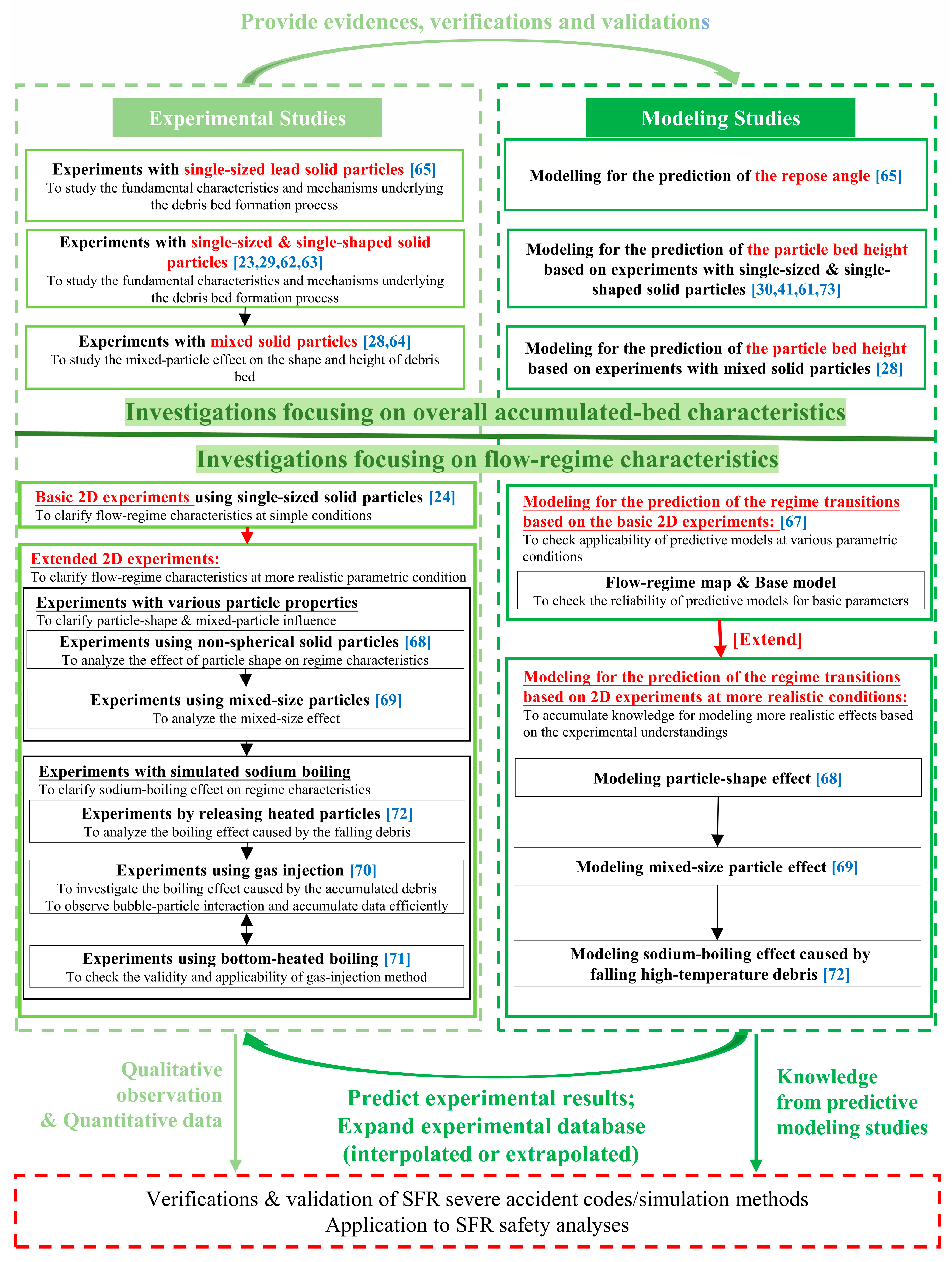

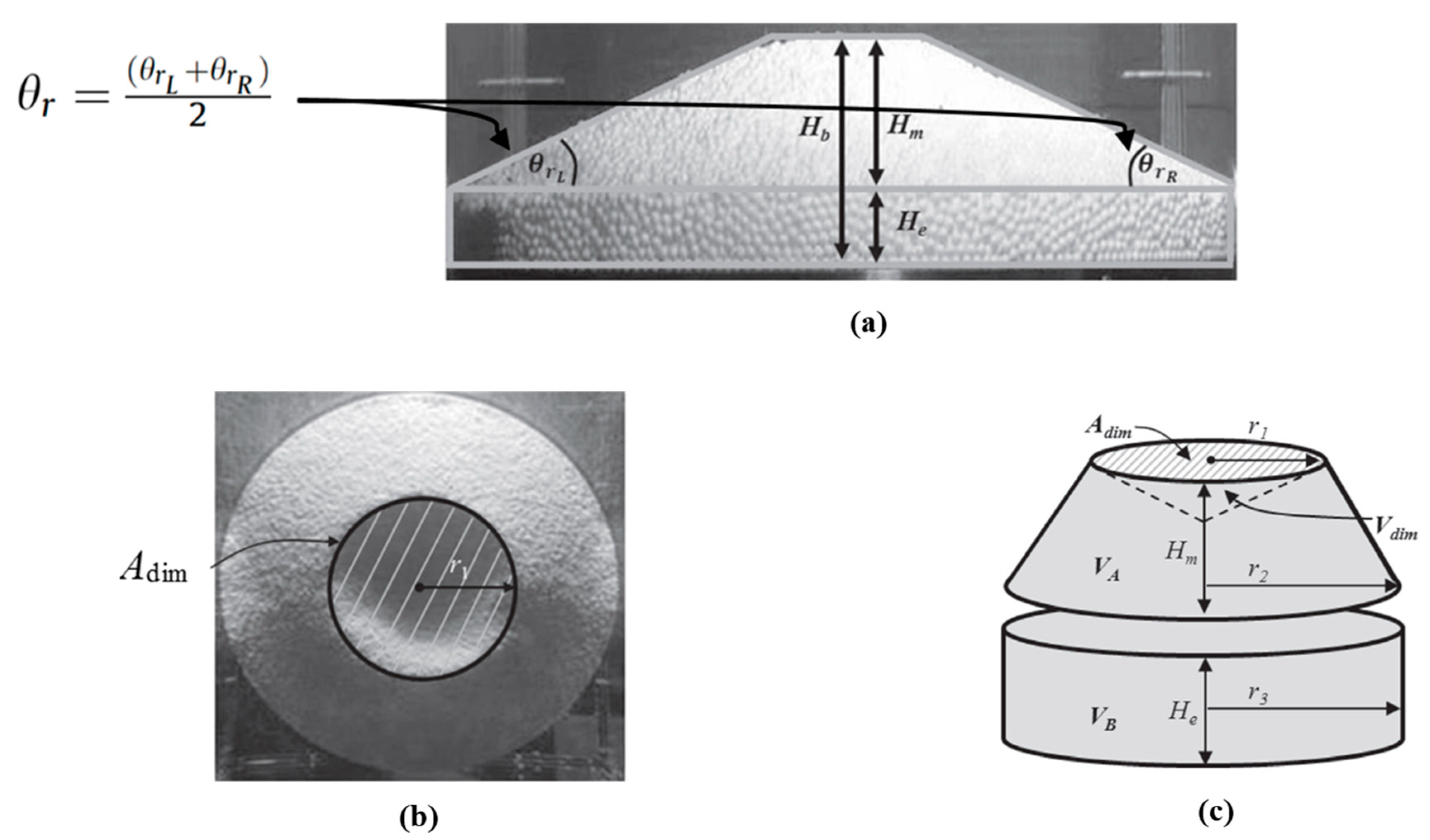

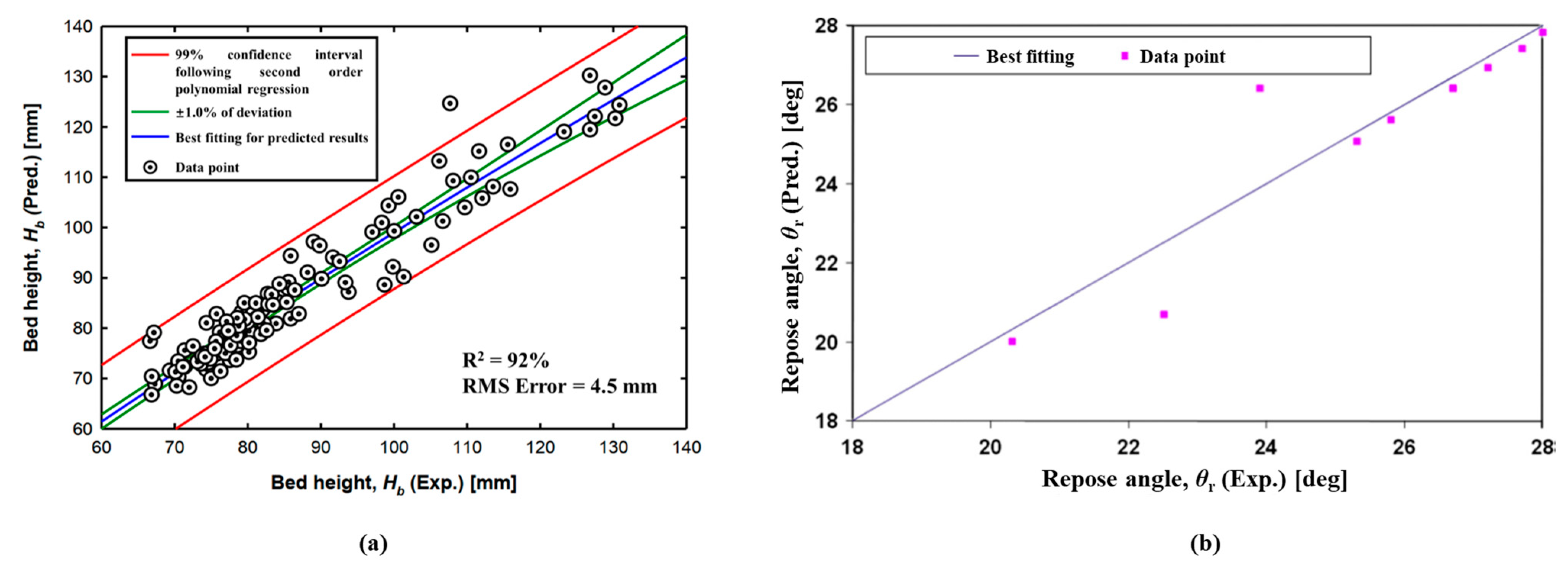
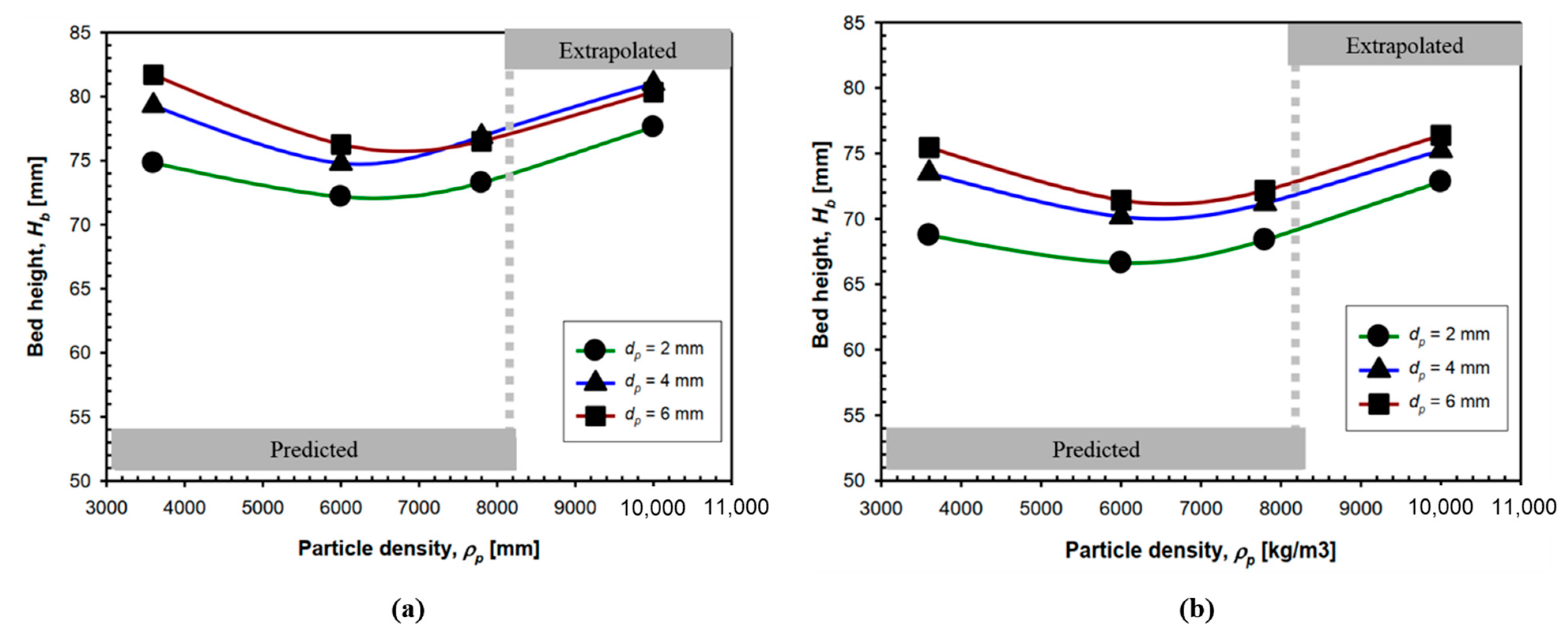
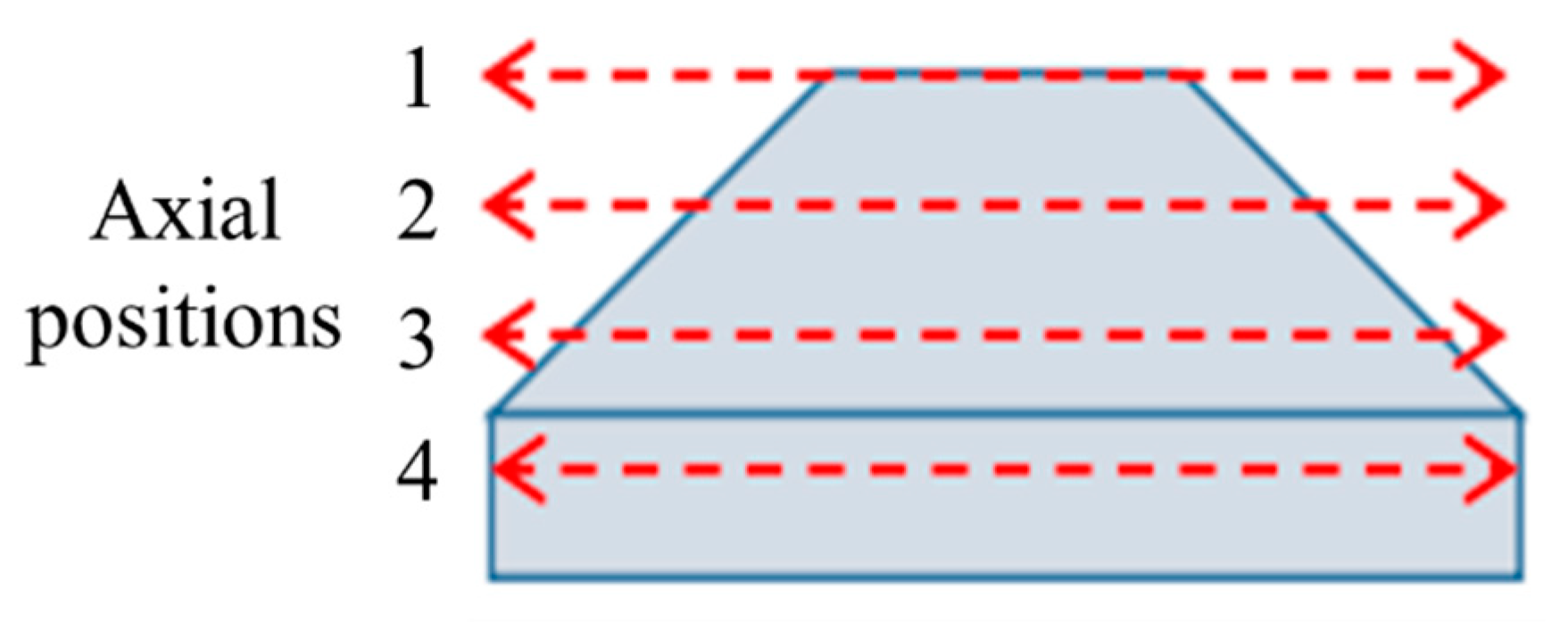
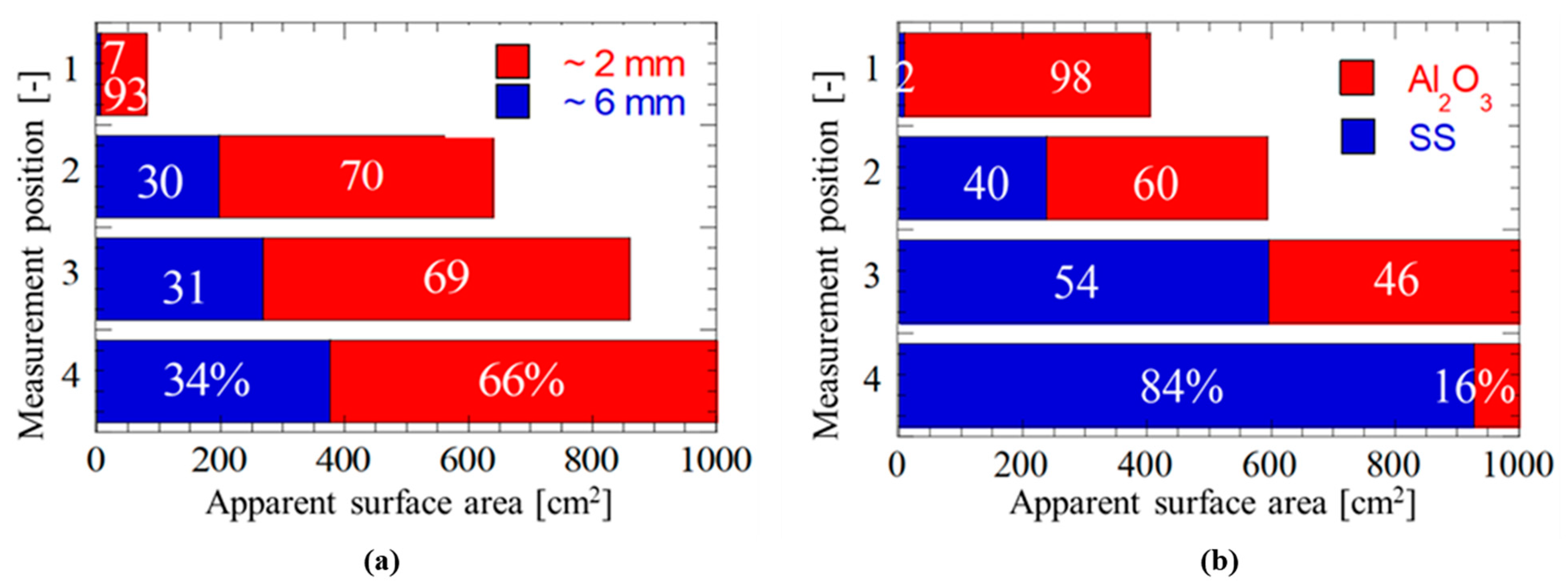
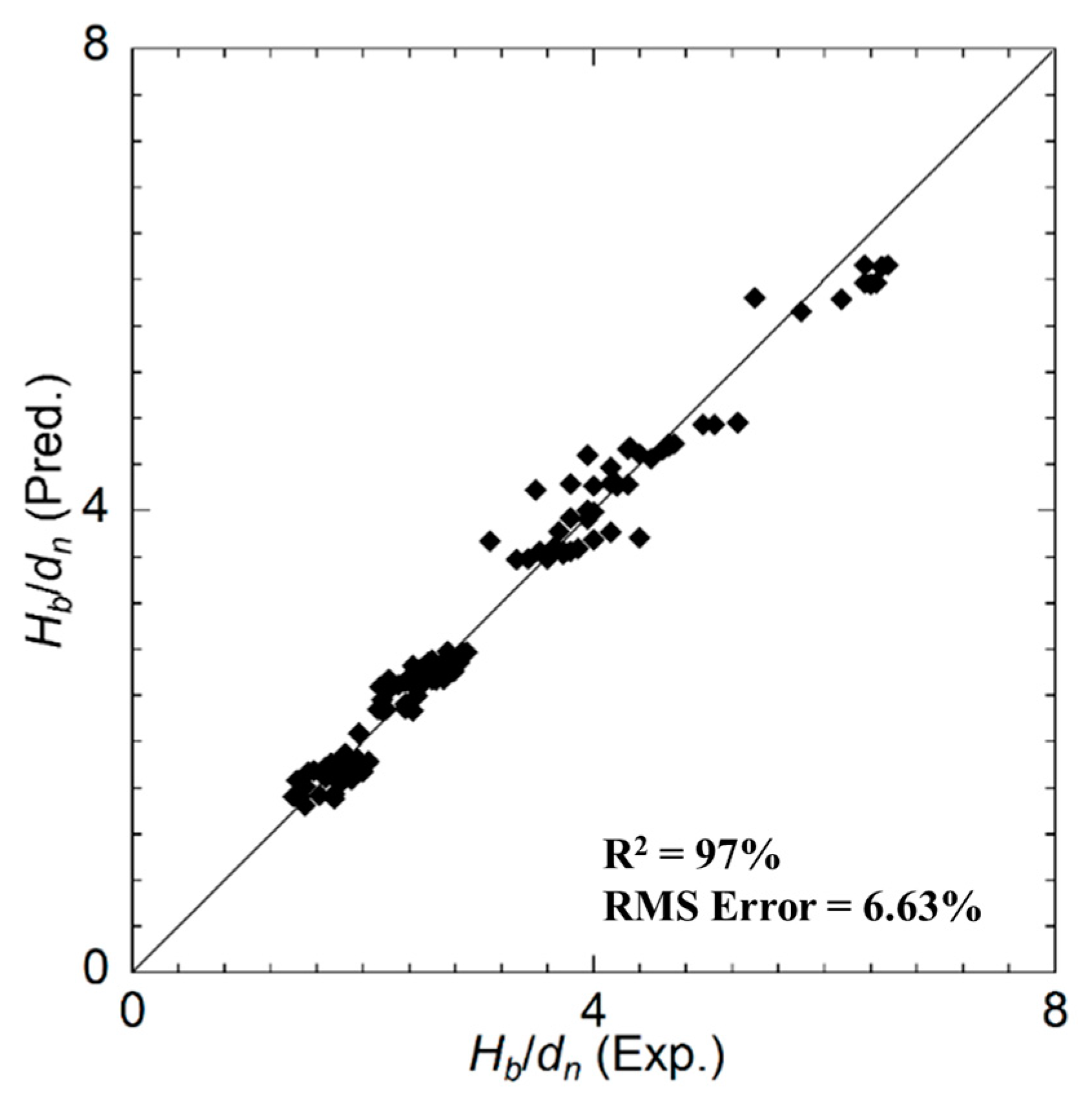
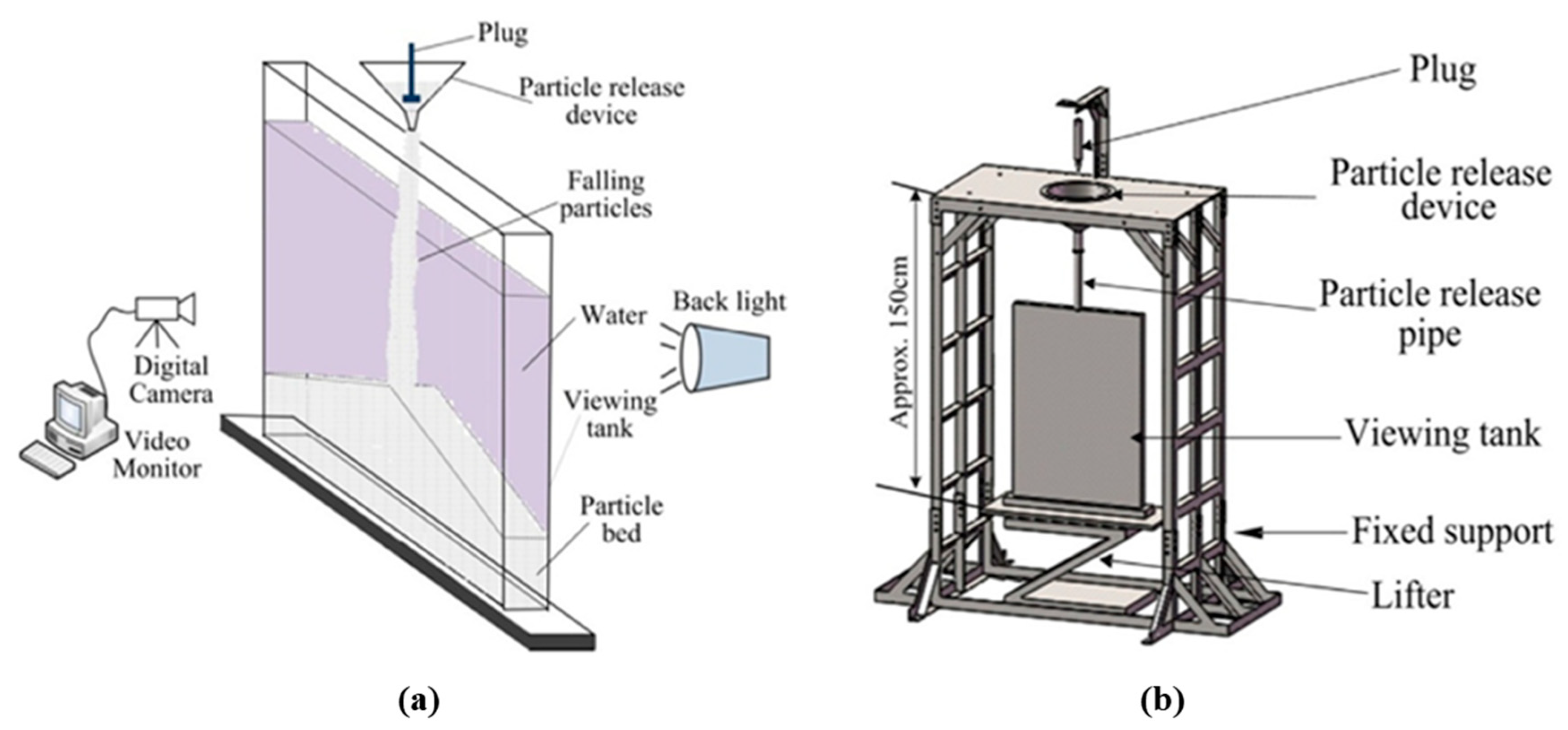

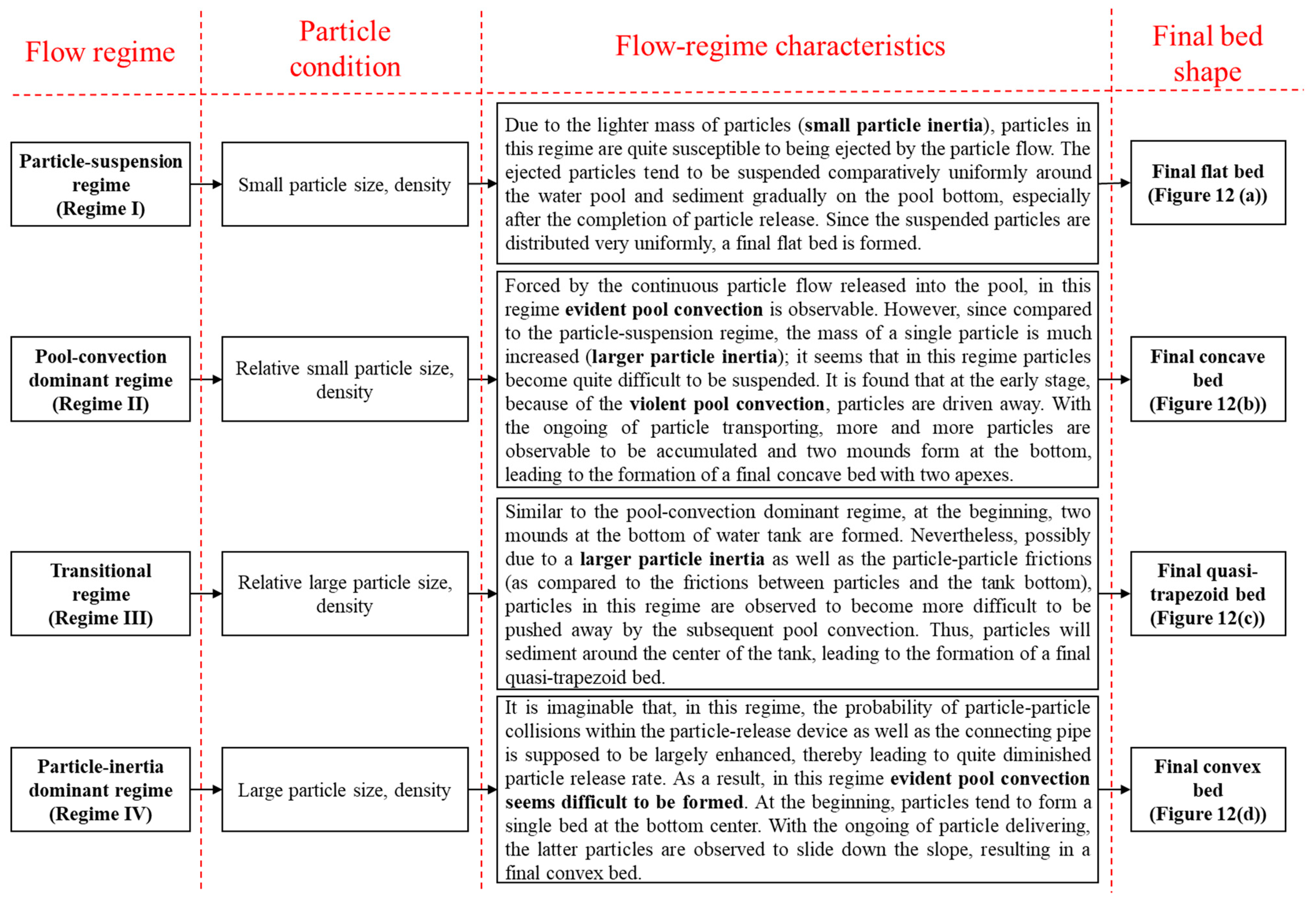


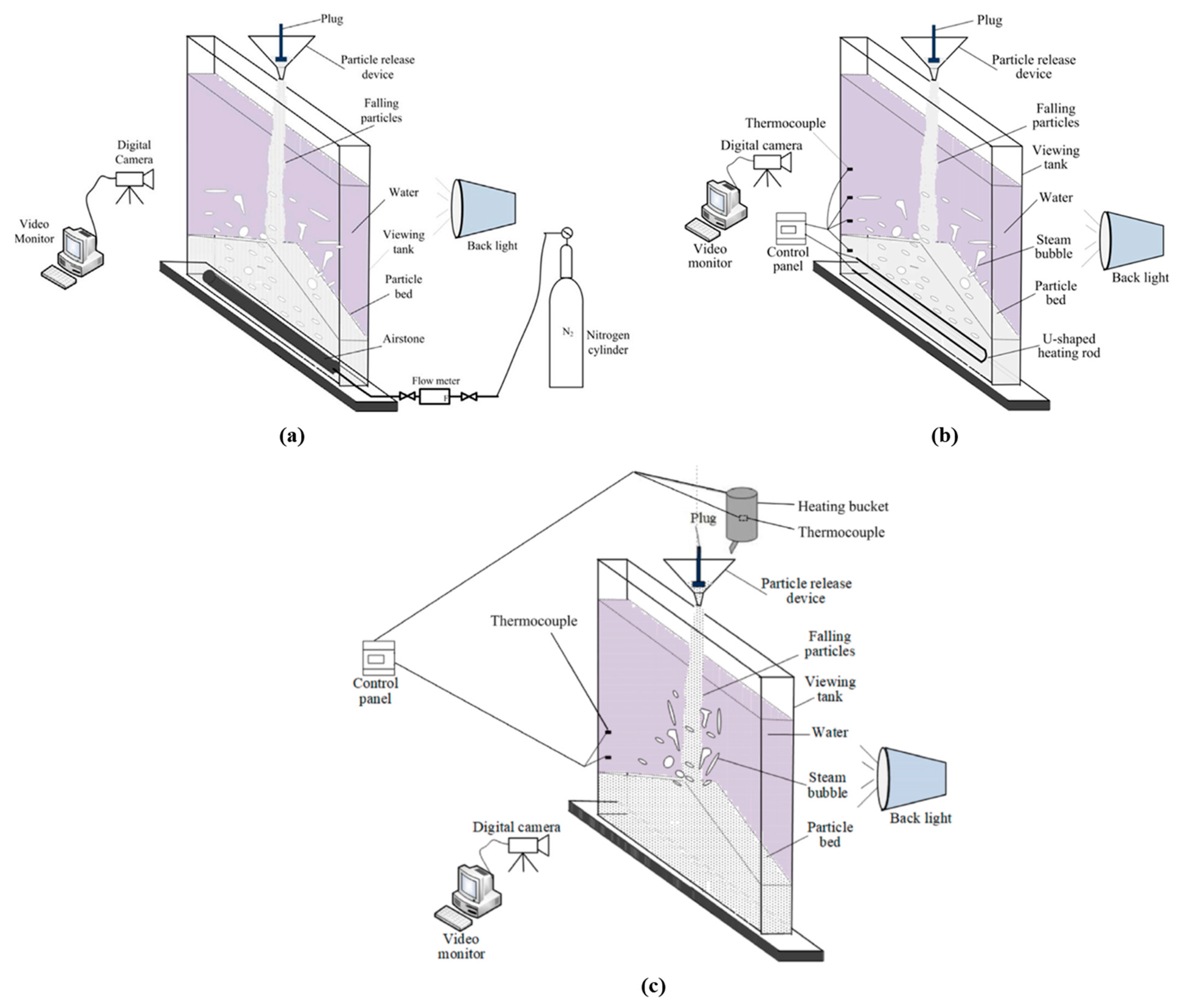
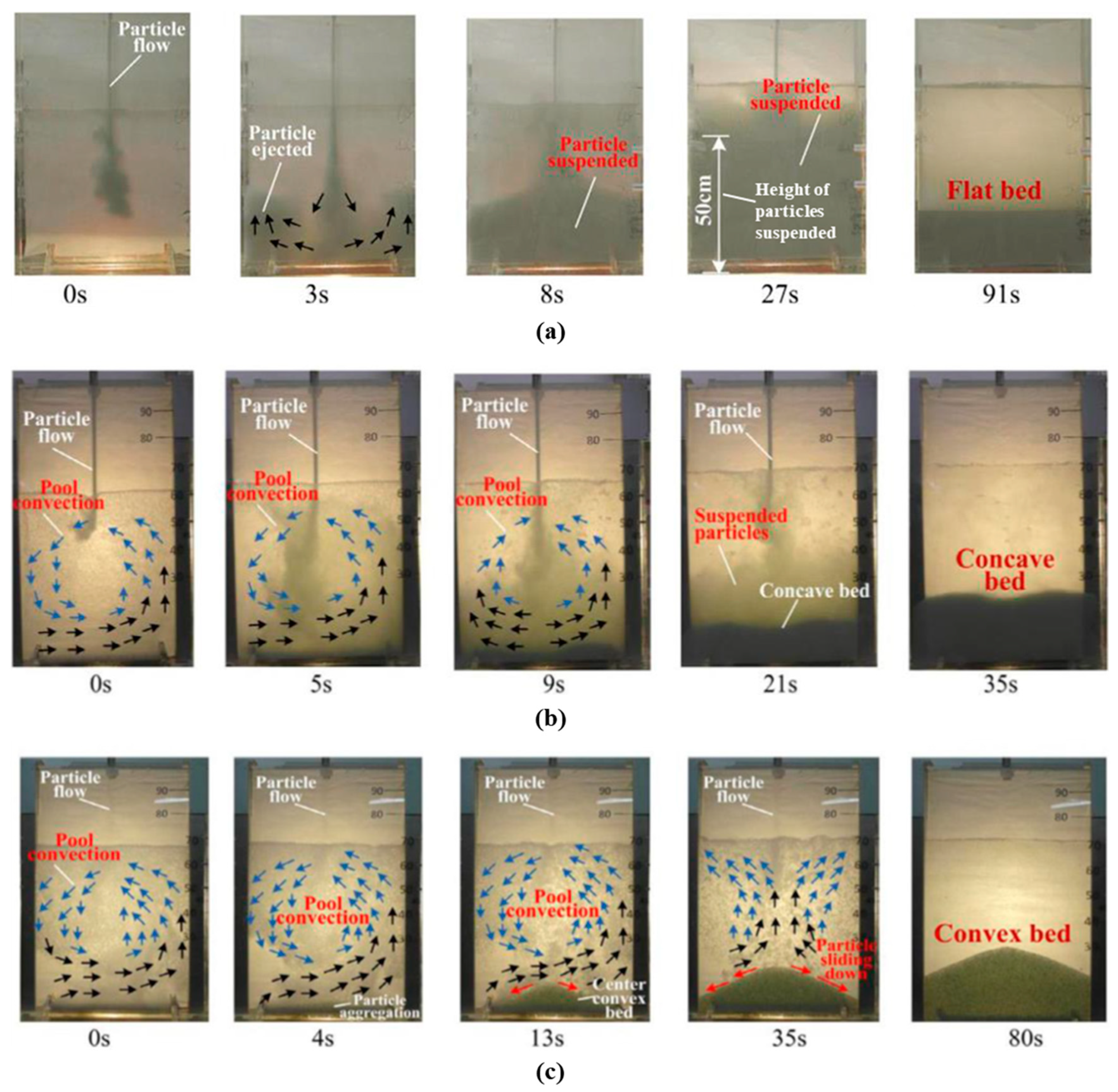
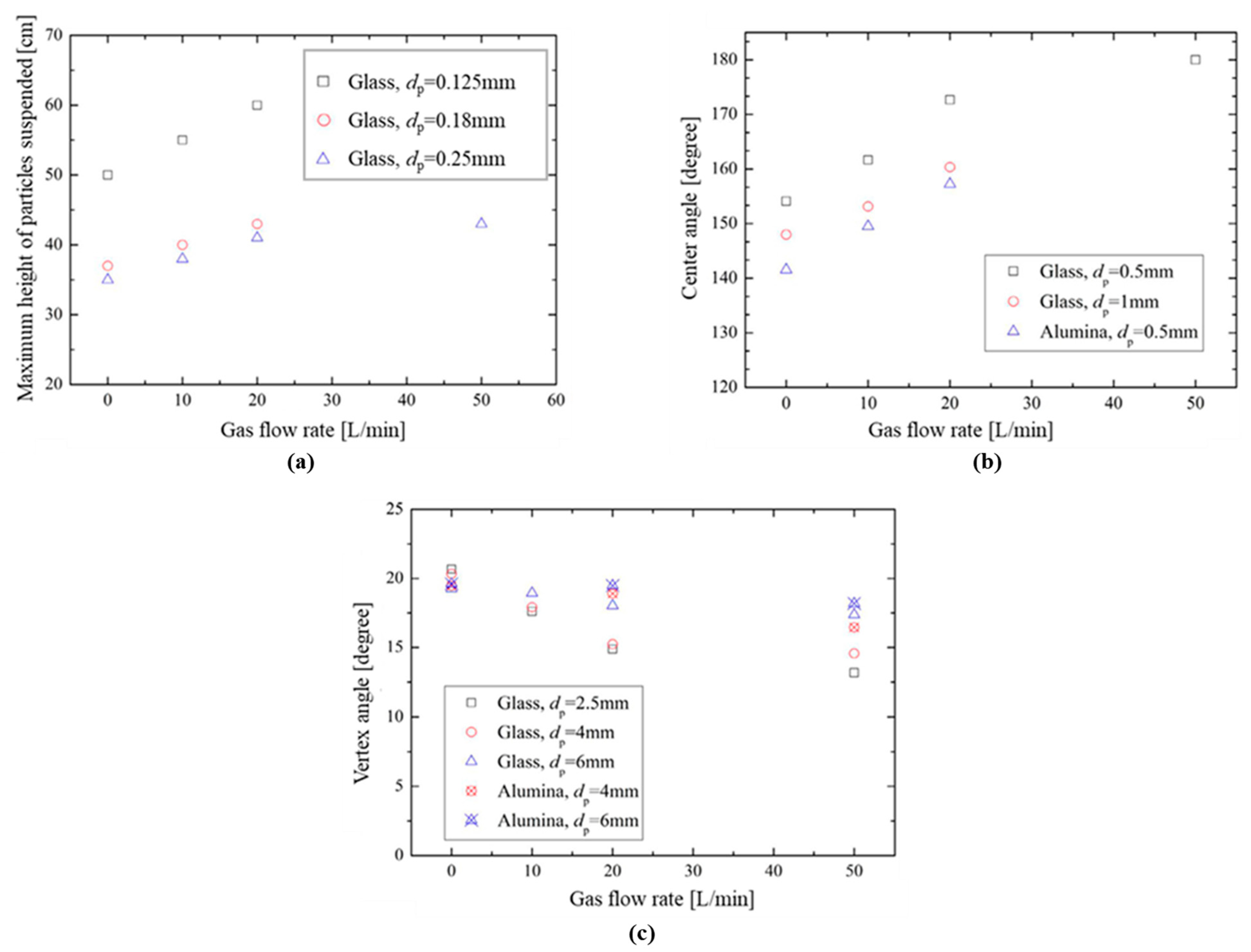
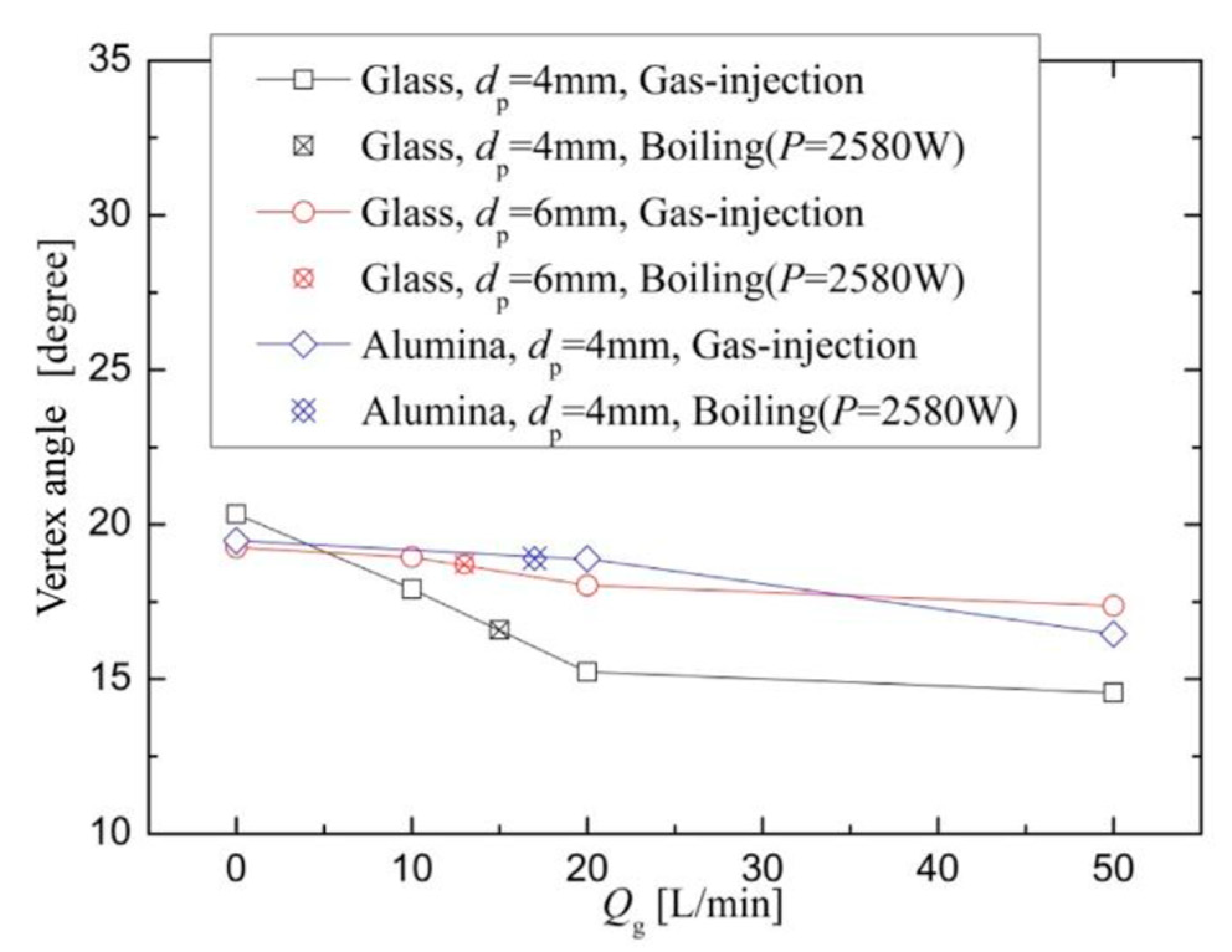
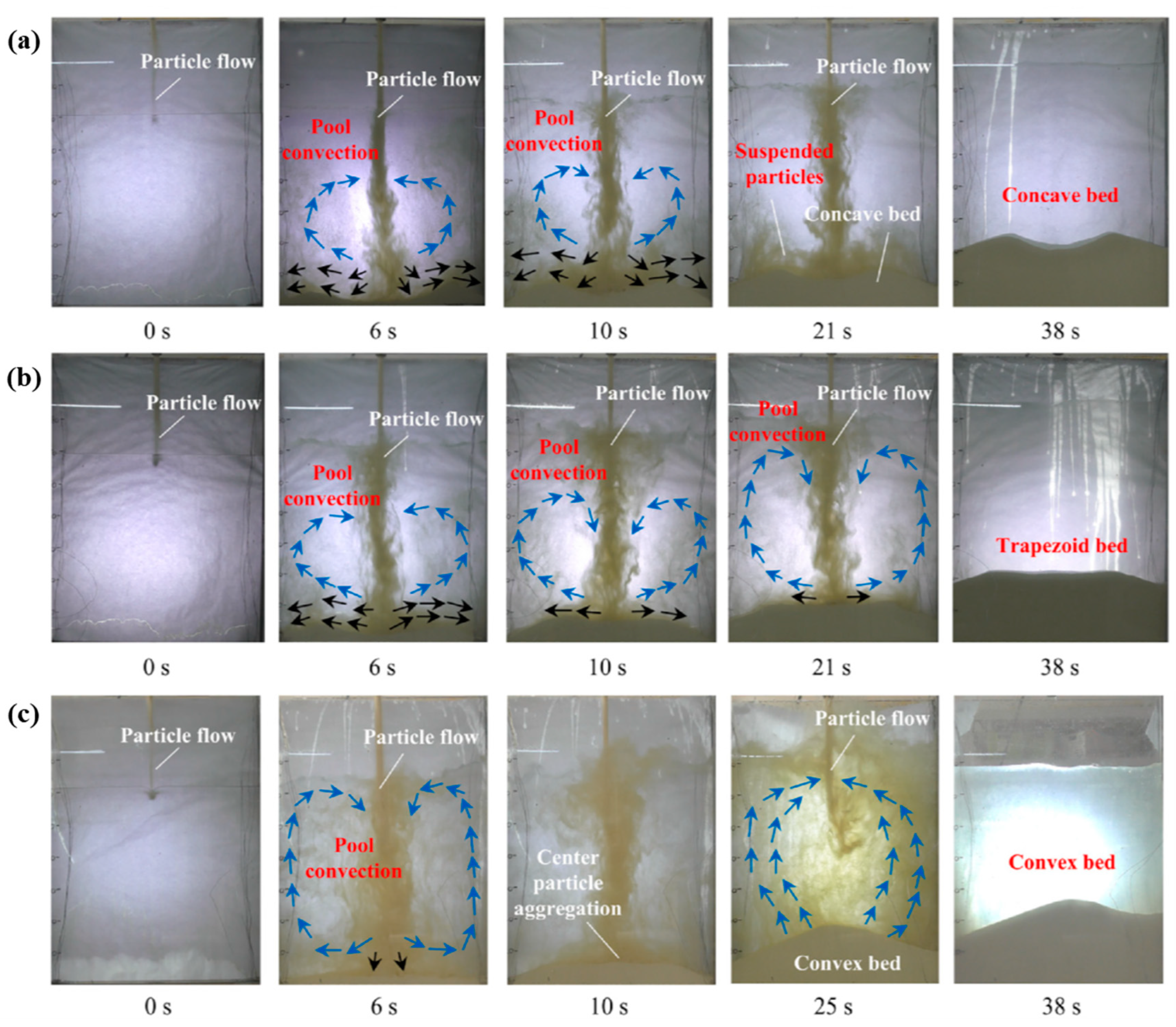
| Physical Quantities | Condition | ||
|---|---|---|---|
| Reactor Accident | Experiments Focusing on Overall Accumulated-Bed Characteristics | Experiments Focusing on Flow-Regime Characteristics | |
| Material of debris | Mixture of MOX fuel and SS | Al2O3, ZrO2, and SS | Glass, Al2O3, ZrO2, SS, Cu, and Pb |
| Density of debris (kg/m3) | 7620 (SS)∼10,800 (MOX fuel) at 1000 K | 3600 (Al2O3), 6000 (ZrO2), 7800 (SS) at 298 K | 2600 (Glass), 3600 (Al2O3), 6000 (ZrO2), 7900 (SS), 8900 (Cu), and 11,340 (Pb) at 298 K |
| Diameter of debris | 0.1 mm to several millimeters | 1.1~6.0 mm | 0.125~8.0 mm |
| Liquid coolant | Sodium | Water | Water |
| Coolant density (kg/m3) | 830 | 997 | 997 |
| Viscosity (Pa.s) | 2.40 × 10−4 | 8.91 × 10−4 | 8.91 × 10−4 |
| Modeling for Single-Sized and Single-Shaped Solid Particle Cases | Modeling for Mixed Solid Particle Cases | ||
|---|---|---|---|
| Empirical Constant Index | Value | Empirical Constant Index | Value |
| a1 | −0.425 | a2 | 1.36 |
| b1 | −0.103 | b2 | 3.76 |
| c1 | −0.407 | c2 | 0.589 |
| d1 | −0.161 | d2 | −0.661 |
| e1 | −0.585 | e2 | −1.60 |
| f1 | 0.456 | f2 | −0.545 |
| g1 | 0.035 | g2 | 0.490 |
| h1 | −0.137 | k2 | 162,755 |
| k1 | 0.2049 | ||
| Empirical Constant | Value |
|---|---|
| a | 1.20 |
| b | 0.60 |
| c | 0.90 |
| d | 1.05 |
| KB | 1.01 × 10−8 |
| s1 | 65.5 |
| s2 | 0.263 |
| s3 | 0.441 |
| p1 | 122.451 |
| p2 | 0.555 |
| p3 | 0.625 |
| r1 | 0.016 |
| r2 | 1.295 |
| r3 | 0.012 |
Disclaimer/Publisher’s Note: The statements, opinions and data contained in all publications are solely those of the individual author(s) and contributor(s) and not of MDPI and/or the editor(s). MDPI and/or the editor(s) disclaim responsibility for any injury to people or property resulting from any ideas, methods, instructions or products referred to in the content. |
© 2023 by the authors. Licensee MDPI, Basel, Switzerland. This article is an open access article distributed under the terms and conditions of the Creative Commons Attribution (CC BY) license (https://creativecommons.org/licenses/by/4.0/).
Share and Cite
Xu, R.; Cheng, S. Characteristics and Mechanisms of Debris Bed Formation Behavior in Severe Accidents of Sodium-Cooled Fast Reactors: Experimental and Modeling Studies. Appl. Sci. 2023, 13, 6329. https://doi.org/10.3390/app13116329
Xu R, Cheng S. Characteristics and Mechanisms of Debris Bed Formation Behavior in Severe Accidents of Sodium-Cooled Fast Reactors: Experimental and Modeling Studies. Applied Sciences. 2023; 13(11):6329. https://doi.org/10.3390/app13116329
Chicago/Turabian StyleXu, Ruicong, and Songbai Cheng. 2023. "Characteristics and Mechanisms of Debris Bed Formation Behavior in Severe Accidents of Sodium-Cooled Fast Reactors: Experimental and Modeling Studies" Applied Sciences 13, no. 11: 6329. https://doi.org/10.3390/app13116329
APA StyleXu, R., & Cheng, S. (2023). Characteristics and Mechanisms of Debris Bed Formation Behavior in Severe Accidents of Sodium-Cooled Fast Reactors: Experimental and Modeling Studies. Applied Sciences, 13(11), 6329. https://doi.org/10.3390/app13116329






